A long-schnozed, Pepto Bismol creamsicle of a bird landed in Huntley Meadows about a week ago, and it’s causing the birders of the Washington, D.C. greater metro area to collectively loose their ever-lovin’ minds.
It’s a roseate spoonbill — birds that were, according to Audubon “virtually eliminated from the United States as a side-effect of the destruction of wader colonies by plume hunters,” but that are now “locally common in coastal Florida, Texas, and southwest Louisiana.” It’s rarely (or never) been seen this far north before — a friend and ornithologist theorized that possibly, it was blown north by one of the storms we’ve been having? — and anyone in the DMV (DC-Maryland-Virgina area) who has ever cast a fluttery glance in the direction of a bird is headed out to take a look.
I’ve never been part of a bird mania before this one, and have rarely been swept into a search for any particular species at all. My birding, such as it is, mainly consists of listening to a lot of confusing bird songs and thinking, “I bet there are some birds there,” and, “what was the name of that Shazam-for-bird-songs app? I really should get that,” and also “there’s absolutely no way people can possibly remember that jumble of notes, they’re totally lying.”
And then if I’m lucky I’ll see a bird I might recognize, like a robin or a Canada goose or someone might tell me about the bird I can’t recognize yet, and that’s how I’ve learned about weirdos like the hooded merganser or pretty speed demons like the barn swallow.
This time, though — in the absolute most pared-down way ever — I would be joining the ranks of the the like of twitcher Lee Evans.
Lee Evans has a blog called, “The Diary of an Obsessive Twitcher,” and subtitled, “This is the daily birding blog of perhaps the UK’s most obsessive birdwatcher — the notorious Lee Evans.”
On his recent interview on the podcast, “The Wild with Chris Morgan,” Evans has Morgan jumping in his car and driving Evans 50 miles across the UK to catch sight of bramblings, a small brown bird that looks exactly the way its name sounds.
Evans has had four wives, he tells Morgan on the way to the sighting, but they the first three divorced him due to the birding, and I get distracted, marveling at this marital bounty, even as the interview continues.
Who were these women? How did he meet them, consumed as he is by avian affairs? How did he find the time to date and marry them? I imagine the marriages, possibly taking place at some charming rustic setting, the emerald hills of England all a-glow with the setting sun, the guests flush with champagne, and then the groom running off at regular intervals, a-flame with passion over this passing chirp or that winged flutter.
I hope they have a club, his divorcees, and talk about the moment when if first began to dawn on them that, sure, anyone could play second fiddle to a mute swan, but finding that your husband is way more interested in investigating tufted titmouses rather than … let’s say your own tufted titmouse … that was a bridge too far.
Now, though, I would be joining the furor.
The rumor was that the roseate spoonbill had settled into the back mud flats, where the egrets usually hang out.
I arrived Tuesday evening, after work. As I made my way back towards the observation deck, I passed grinning birder after grinning birder, many with bazooka-sized cameras and binoculars slung around their necks. “It’s back there,” they all said.
I nodded, smiled, walked a bit faster.
The problem with chasing a particular animal or species, I find, is that it convinces me that the animal was doing something incredible right before I arrived, and will do something spectacular right after I leave, but it’s never doing that thing when I’m there.
I got to the observation deck and then the boardwalk beyond, finding my place among the fifteen or so photographers and nature lovers remaining, all of us staring at a tiny pink dot in the muddy distance. Nothing was happening. Within a couple of minutes, the sun slipped below the tree line, casting everything into shade.
“There’s a raccoon,” someone pointed out.
We all took photos of the raccoon for a little while.
I thought about all the grinning photographers who had been walking out when I had been walking in. Were they better, simpler people, people who were content with their lot in life? If they traveled 40 minutes or longer in rush hour traffic on a Tuesday, only in order to see a pink dot on the brown horizon, what of it?
Or, alternately, had they seen everything they wanted to see? Had they gotten *the shot*? Had the spoonbill done his majestic mating dance and wiggled his absurd beak at them? And *that’s* why they had grinned, those fuckers, they had gotten it all, and now it was over and I had missed it.
I thought of his Billy Collins poem, “The Sandhill Cranes of Nebraska”:
Too bad you weren’t here six months ago,
was a lament I heard on my visit to Nebraska.
You could have seen the astonishing spectacle
of the sandhill cranes, thousands of them
feeding and even dancing on the shores of the Platte River.There was no point in pointing out
the impossibility of my being there then
because I happened to be somewhere else,
so I nodded and put on a look of mild disappointment
if only to be part of the commiseration …
I came back again the next morning before work, hooked now, determined, there had to be more to life and to this bird than just a dot on the horizon. I shocked myself with the time I set the alarm, shocked my cat with the time her food bowl hit the floor, got out the door before I could even think, “this is ridiculous,” and I saw the roseate spoonbill in better lighting.
I stood amongst a new crowd of photographers, maybe 25 or 30 of us now, in the already-muggy heat, though it was still very early morning, and we waited for the bird to rise, to groom himself, to possibly consider breakfast. He did not do a fabulous mating dance for me. I didn’t get *the shot*.
The egrets plumped their lacy hind-feathers and approached the spoonbill and retreated, approached and retreated. They’d let him stay, but they weren’t happy about it. Don’t try to fool *them* by saying he’s an egret. No egret they’ve ever seen is pink. The spoonbill gave ground a little, then came back. He seemed nervously sure that if he stood still long enough, he might blend in, possibly become an egret himself.
The roseate spoonbill getting mobbed by an egret, a great blue heron, and a mallard duck.
Someone pointed out the osprey as he made a dive. I made an awkward joke about the barn swallow (I was 99% sure it was a barn swallow) and someone else laughed. It was enough.
Osprey breakfast
Barn swallow
I was no Lee Evans and never would be, but I could walk back to the parking lot, and smile at the new folks coming in, point behind me and say, “yep, he’s back there, back in the deep mud flats. He’s pretty far out there, and the egrets aren’t crazy about him, but you can still see that fine schnoz. Never seen anything quite like it. Might not ever again.”

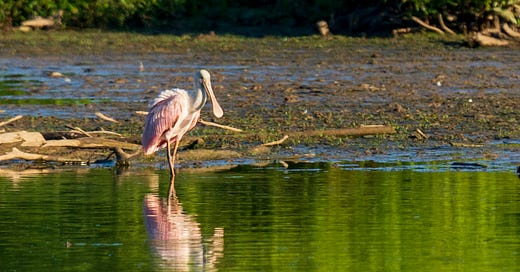


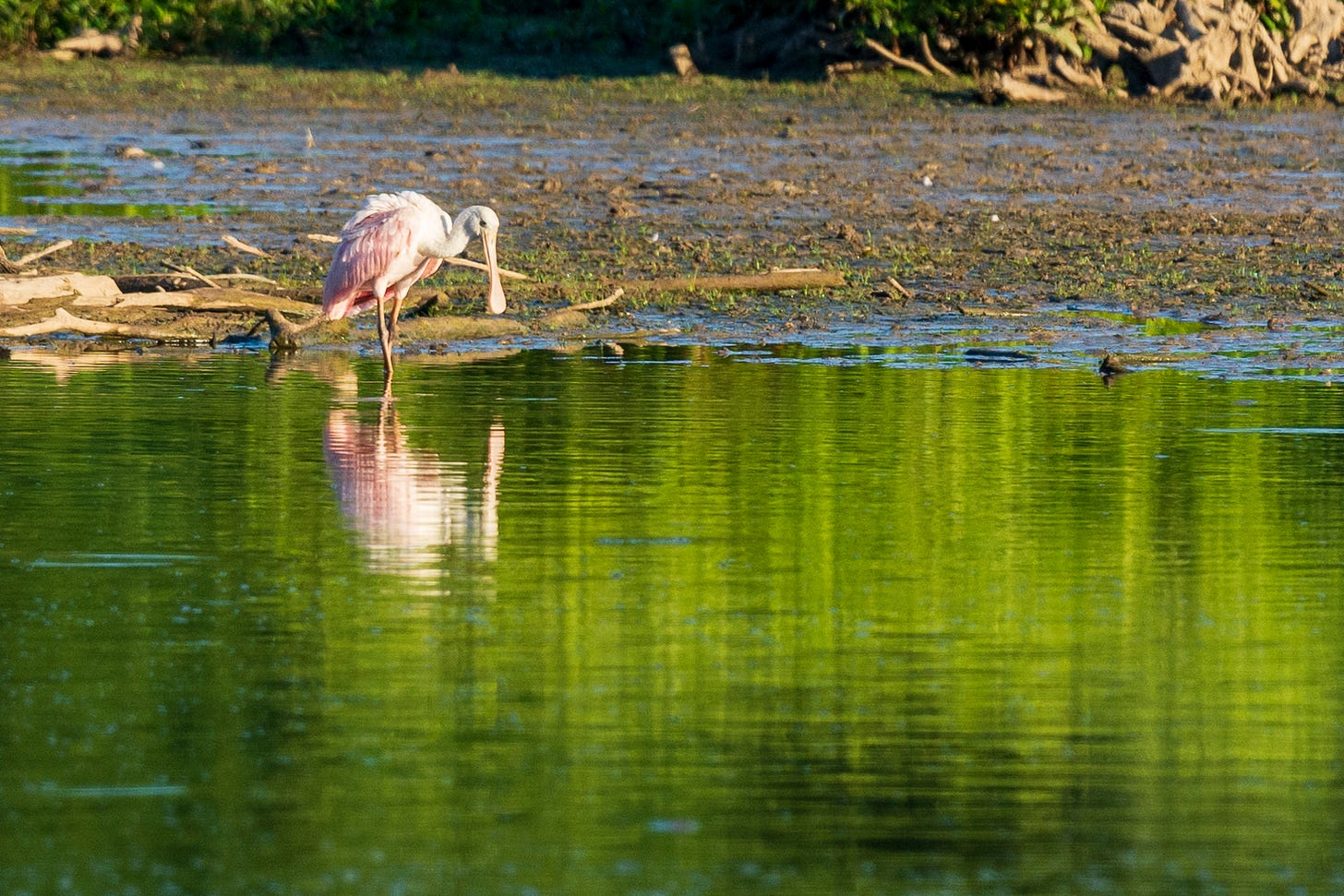

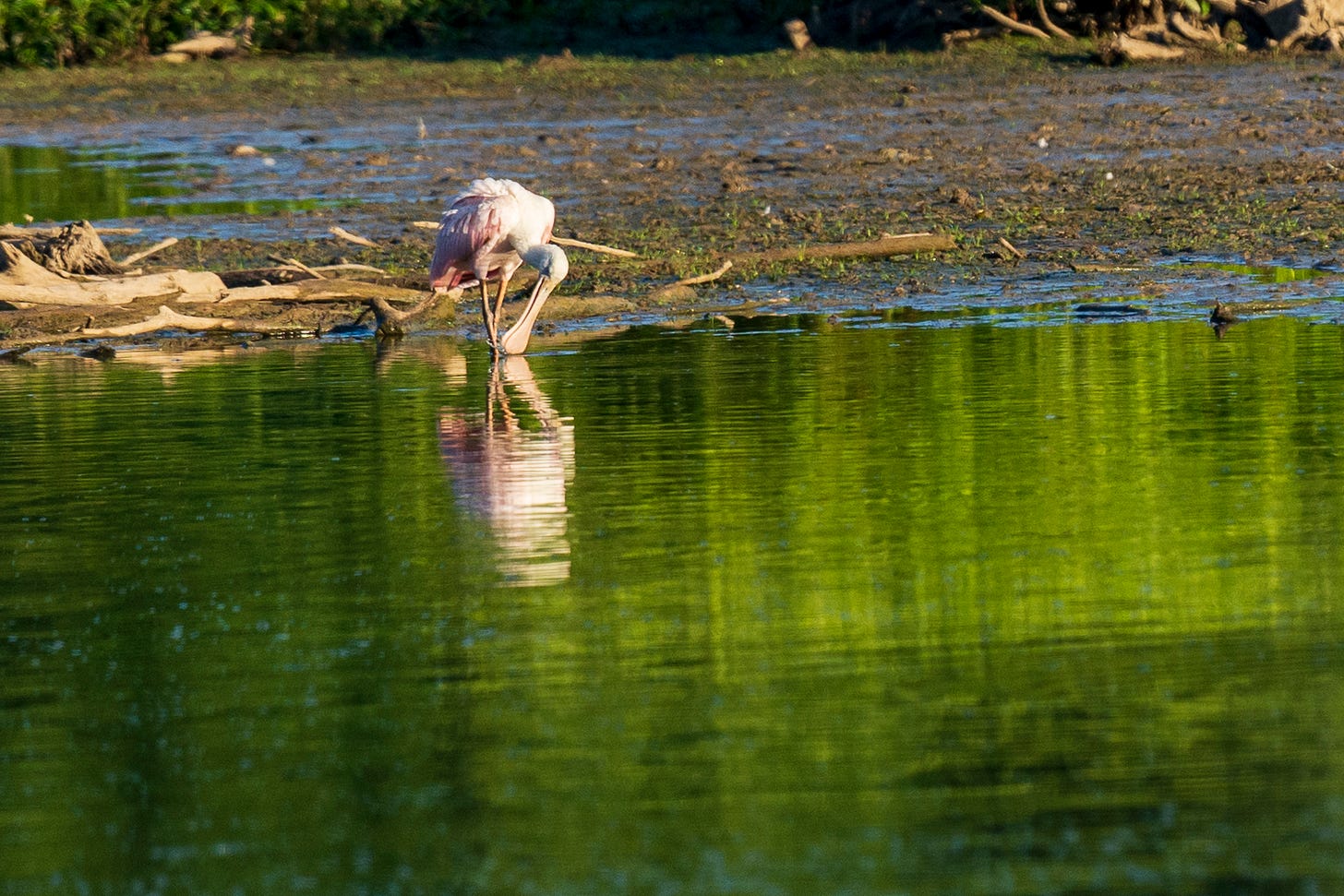
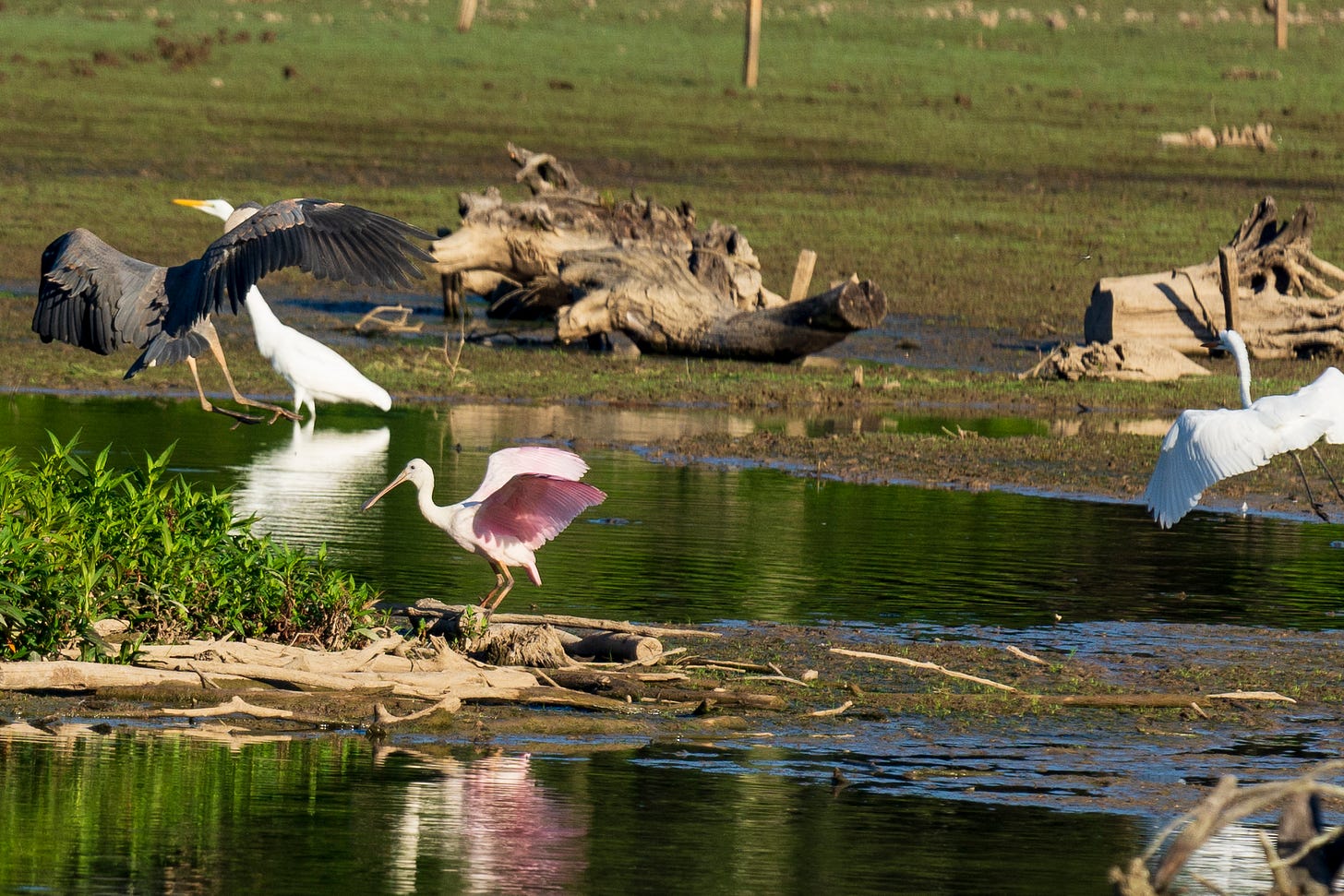
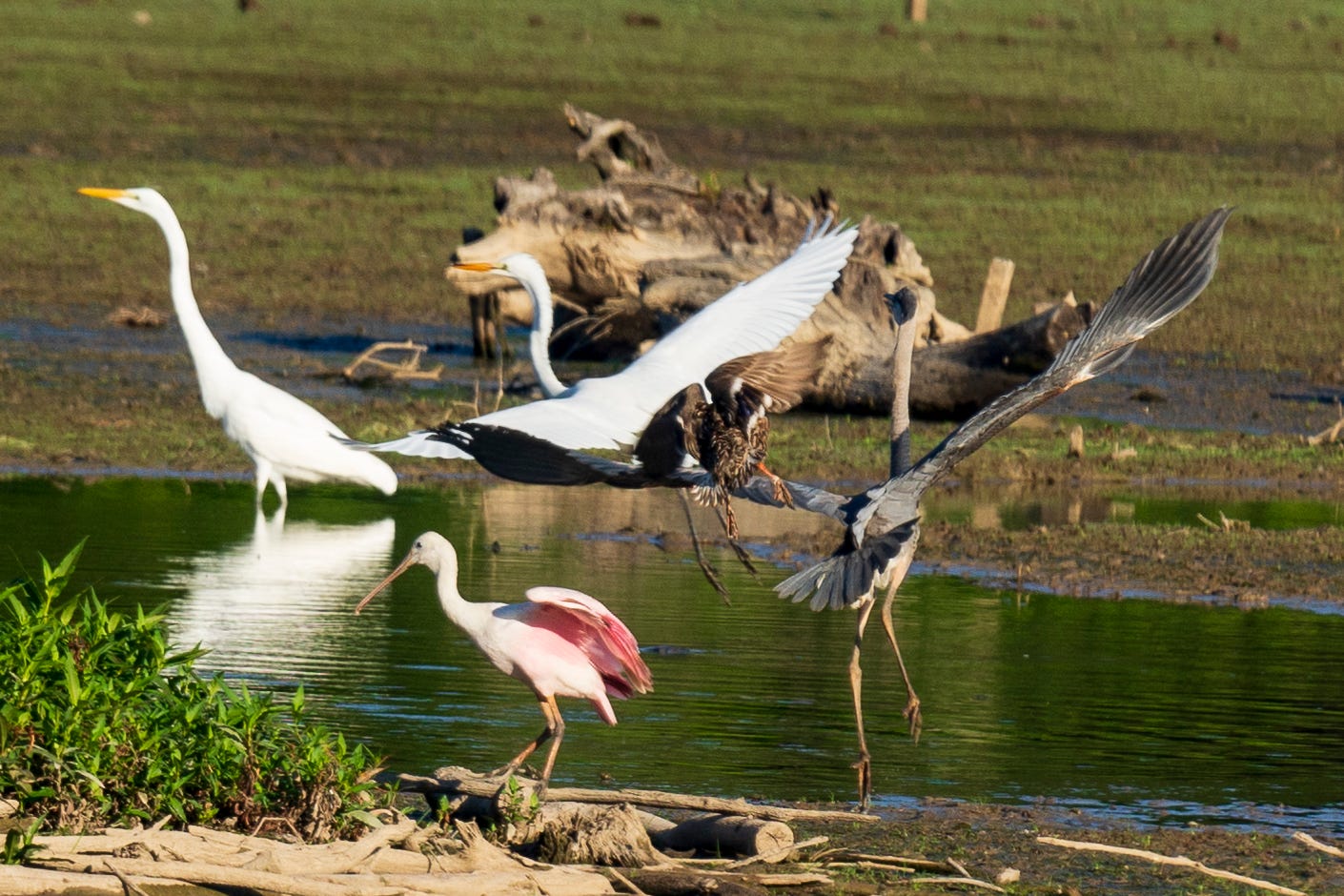
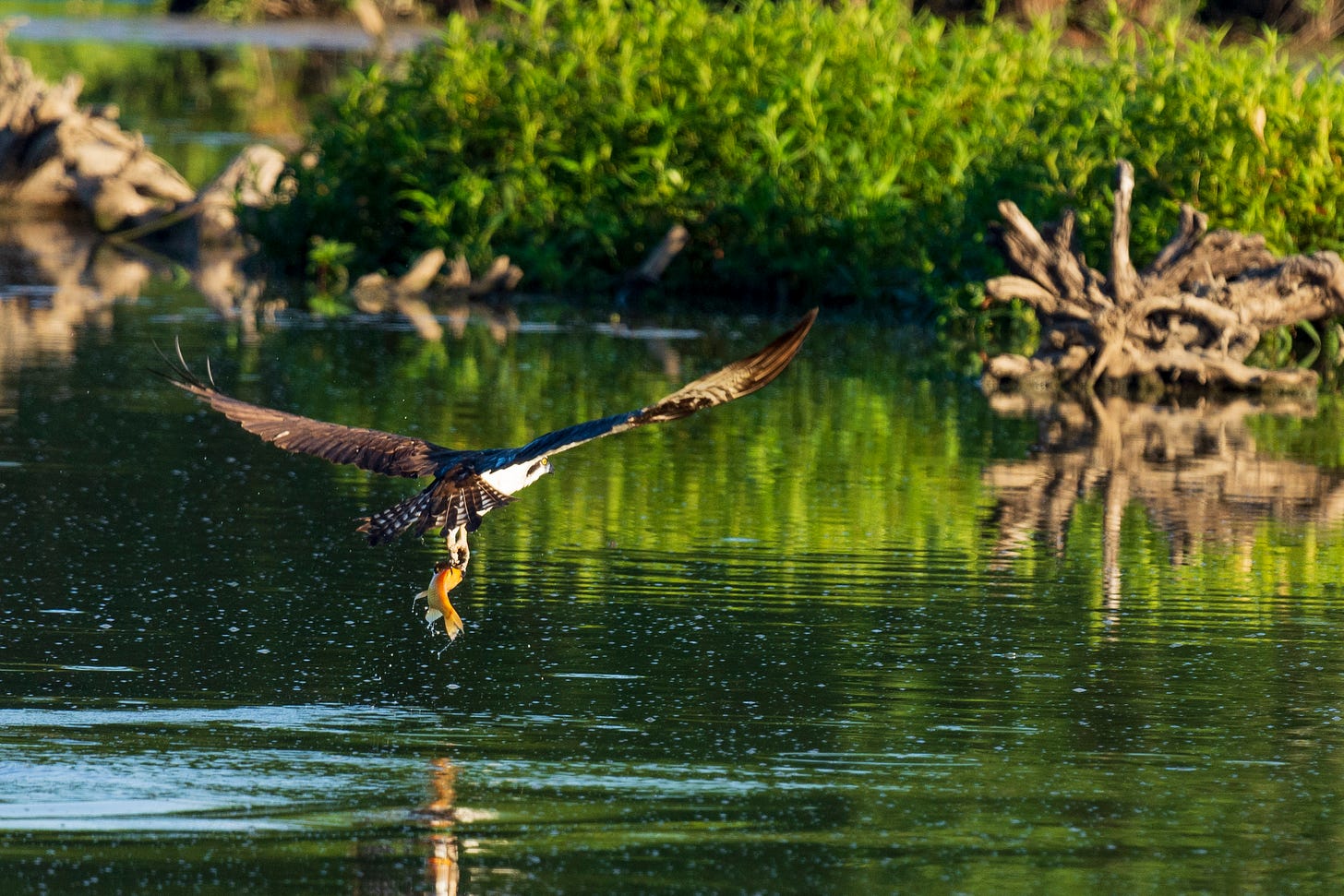

That's a bird worth the trouble.